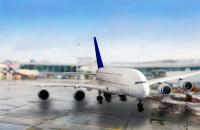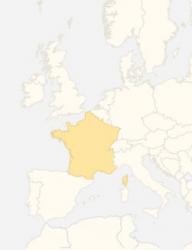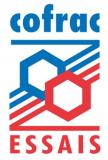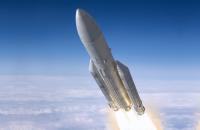Aerospace product qualification - Airbus, Boeing, RTCA / DO-160 testing
The safety of air transportation requires aircraft qualifications to be the most demanding in the world. It is only natural that aircraft manufacturers pass on these stringent requirements to their equipment manufacturers via their technical specifications.
These specifications take account of requirements concerning shocks, vibration, moisture, heat and cold, etc., and also in relation to electromagnetism in order to ensure the compatibility of different equipment items or take account of natural phenomena (lightning, electrostatic discharges, etc.), and to meet specific requirements for this equipment (high level of immunity, etc.).
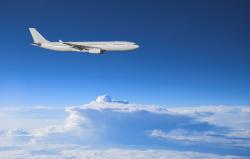
The purpose of the qualification of an equipment item or of one of its sub-assemblies is to confirm that it will operate as expected in relation to the requirements defined for its life profile. In the aviation sector, the requirements are generally high. Specific tests (altitude, windmilling, etc.) have been specifically designed to take account of the specificities of air transportation.
In this context, the Emitech Group operates as
- a third-party company guaranteeing the independence of the testing campaign
- an expert in the environmental testing field to clarify or specify the requirements, tests and the interpretation of the results
- laboratories in complementary fields of activity allowing for the coordination and performance of most or indeed all of the tests required by a specification.
Outstanding, complementary resources for a comprehensive approach to your testing campaigns
Our test facilities specific to automotive qualifications represent the biggest accommodation capacity on the market in terms of:
- our ability to conduct numerous testing campaigns simultaneously (180 campaigns in all fields)
- our ability to adapt to your time constraints by offering flexible working arrangements: in two eight-hour shifts and on Saturdays.
- our range of services incorporates equipment and resources dedicated to the most specific requirements (lightning, High Intensity Radiated Field, direct and alternating current systems from 50 to 800 Hz 45kVA x3, systems cages, 105 kN vibrators, 93 m3 chamber and hydraulic equipment using different fluids).
Standards and specifications (not exhaustive list)
- AIRBUS
- BOEING
- BOMBARDIER
- DASSAULT
- AIRBUS HELICOPTER
- DASSAULT
- ARIANE
- ...
The RTCA DO-160G "Environmental Conditions and Test Procedures for Airborne Equipment" document sets out to define a series of test environments and procedures for on-board equipment in aircraft. The environments and procedures applied to an equipment item depend on the category defined in these documents, according to the type of aircraft, its conditions of use and how the equipment is installed in the aircraft.
This document is also referenced under the name EUROCAE ED-14G.
Mechanical, climatic and physical-chemical environments
Electrical and electromagnetic environments - ECM testing
- Section 15: Magnetic effect
- Section 16: Power input
- Section 17: Voltage spike
- Section 18: Audio frequency conducted susceptibility, power inputs
- Section 19: Induced signal susceptibility
- Section 20: Radio frequency susceptibility (radiated and conducted)
- Section 21: Emission of radio frequency energy
- Section 22: Lightning induced transient susceptibility
- Section 23: Lightning direct effects (not realized within the Emitech Group)
- Section 25: Electrostatic discharge (ESD)
- Airbus: ABD0100.1.2
- Airbus: ABD0100.1.8.1
- Boeing: 787B3-0147
- Boeing: D6-16050-5
- Electromagnetic radiated susceptibility / immunity - RS101, RS103
- Radiated Emissions - RE101, RE102, RE103
- Bulk Current Injection (B.C.I.) - CS114
- Conducted susceptibility / immunity - CS101, CS103, CS104, CS105, CS109,CS115,CS116
- Conducted Emissions - CE101, CE102, CE106
MIL STD 462 was combined with MIL-STD-461D in MIL-STD-461E in 1999.
- Test methods and procedures for determining the conformity of airborne operating equipment with specified electrical power requirements.
- Altitude (MIL STD 202 method 101E, MIL STD 810 method 500.5, MIL STD 883 method 1001)
- High temperature, low température, temperature cycle (MIL STD 810 method 501.5 et method 502.5, MIL STD 883 method 1001)
- Thermal shock(MIL STD 202 method 107G, MIL STD 810 method 503.5, MIL STD 883 method 1011.9)
- Contamination by fluids (MIL STD 810 method 504.1, MIL STD 883 method 2015.11)
- Solar radiation (sunshine) (MIL STD 810 method 505.5)
- Rain (MIL STD 810 method 506.5)
- Humidity (MIL STD 202 method 103B et method 106G, MIL STD 810 method 507.5)
- Fungus (MIL STD 810 method 508.6, MIL STD 883 method 1004.7)
- Salt fog (MIL STD 810 method 509.5, MIL STD 883 method 1009.8)
- Sand and dust (MIL STD 202 method 110A, MIL STD 810 method 510.5)
- Immersion (MIL STD 202 method 104A, MIL STD 810 method 512.5, MIL STD 883 method 1002)
- Acceleration (MIL STD 810 method 513.6, MIL STD 883 method 2001.2)
- Vibration, fatigue, noise, variable frequency, random frequency (MIL STD 810 method 514.6, method 2005.2, method 2006.1, method 2007.2, method 2026)
- Acoustic noise (MIL STD 810 method 515.6)
- Mechanical shocks (MIL STD 810 method 516.6, MIL STD 883 method 2002.3)
- Pyroshock (MIL STD 810 method 517.1)
- Gunfire shocks (MIL STD 810 method 519.6)
- Temperature, humidity, vibrations and altitude (MIL STD 810 method 520.3)
- Icing and freezing rain (MIL STD 810 method 521.3)
- Vibro-acoustic and temperature (MIL STD 810 method 523.3)
- Mechanical vibration of shupboard equipment (MIL STD 810 method 528)
- Flammability (MIL STD 202 method 111A)
- ...
- NATO - STANAG 4370
- NATO - STANAG 2895
- NATO - STANAG 4435
- NATO - STANAG 4436
- NATO - STANAG 4437
- NATO - STANAG 1307
- NATO - STANAG 4234
- NATO - STANAG 4235
- NATO - STANAG 4324
- ...
- GAM EG 13
- DEF STAN 59-41
- DEF STAN 59-411
- DEF STAN 59-113
- DEF STAN 00-35
- ...
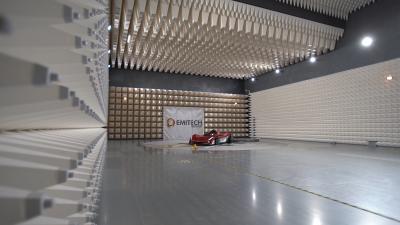
New faraday cage for large equipment (up to 9m45) and high tonnage (40t)
- Electric field strengths of 10 kHz à 40 GHz
- up to 3000 V/m in CW
- up to 10000 V/m Radar pulses (between 1 and 18 GHz)
- MSC Reverberation chambers with test methods DO160 and MIL STD461
- Magnetic fields 10 Hz to 150 kHz
- Bulk Current injection (B.C.I.) up to 1 Ampere from 10 kHz to 3 GHz
- AM, FM, pulse and combined modulations
DC measurements at 40 GHz:
- Current clamps 10 Hz - 1 GHz
- Magnetic field antennas (20 Hz - 30 Mhz)
- Electric field antenna (10 kHz - 40 GHz)
- Temporal analysis (DC - 500 Mhz)
- Transient overvoltage as perRTCA DO160 F/G, ABD 0100.1.8, ABD 0100 1.8.1C (A350), AMD 24C
- Sub-transient voltage and specific waveforms, by direct injection or coupling
- Power cuts
- Combined electrical (AC/DC) and climatic (-70°C - 180°C) testing
- Low-frequency immunity for power supply
- Testing to be performed on direct-current and alternating-current systems from 50 Hz to 800 Hz (3 x 45 kVA bays, can be paralleled to attain 135 kVA, 90 kVA, according to AIRBUS, BOEING, and DO 160 E/F/G section 16 specifications)
- Harmonic measurements
- Conducted susceptibilities MIL STD 461/AECTP 500
- on antenna ports ES 103, 104,105 and NCS 03,04,05
- in damped sine waves S 116, NCS 09
- Amplifiers, transformers, field systems and generators according to RTCA DO 160 C/D/E/F/G, AC 20-136, ABD 0100.1.2
- Generation of Multiple Stroke & Multiple Burst waves according to the following waveforms:
- WF1 or 4: 6,4/70 μs
- WF5B: 50 / 500 μs
- WF5A: 40 / 120 μs
- WF2: 0,1 / 6,4 μs
- WF3: 1 MHz et 10 MHz
- WF6: 0,244 / 4 μs
- Up to level 5 of DO 160 and even beyond for WF5A (Airbus ABD levels)
- Up to30 kV (C = 150 pF, 330 pF, 500 pF, ... and R = 330 Ω, 2 kΩ, 500 Ω, 5 kΩ, ...)
- Measurement of transfer impedance of cables and connectors in a triaxial cell (EN 62153-4-7, EN 62153-4-3) from 10 kHz to 200 MHz
- Measurement of transfer impedance of connectors by an injection line (EN 62153-4-7, EN 60512-23-3) from 10 kHz to 100 MHz
- Measurement of transfer impedance by a bulk current injection (BCI) clamp from 10 kHz to 200 MHz
- Measurement of shielding performance in a mode-stirred reverberation chamber (EN 61726) from 200 MHz
- Number: 8
- Usable volume: 0.4 to 13 m3
- Automated cycles (salt spray, drying, moist heat)
- Number: 6
- Temperature: -70 to +190 °C
- Transfert time: under 10 s
- Software control
- Usefull dimension (mm): 790 x 740 x 850
- Number: 60
- Usefull volume: from 0,1 to 93m3
- Temperature range: -70 to +650 °C
- Rapid temperature variations: 20 °C/min
- Humididy: from 10 to 100 % Hr
- Number: 6
- Temperature range: -70 to +150 °C
- Rapid temperature variations: 20 °C/min
- Humididy: from 20 to 100 % Hr
- Software control, remote alarms
- Usefull dimension (mm): 1200 x 1200 x 1200
- Number: 35
- Frequency: 3 to 3000 Hz
- Force: 7 to 105 kN
- Displacement: 300 mm
- Table simensions (mm): 1500 x 1500
- Number: 12
- Frequency: 0 to 300 Hz
- Force: 200 kN
- Displacement: 300 mm
- Table simensions (mm): 3000 x 3000
- Number: 2
- Frequency: 2 kHz à 50 kHz
- Force: 250 kN
- Max. acceleration: 100g
- Force: 5 000 N
- Frequency: 0.1 - 50 Hz,
- Max. acceleration: 30 gn
- Max. speed: 6.0 m/s
- Displacement: 350 mm peak-to-peak
- Max. mass: 50 kg
- Associated horizontal table, adjustable from 400 mm to 600 mm
- Number: 4
- Max. acceleration: 400 g
- Max. diameter: 3000 mm
- Number: 8
- Max mass: 1 t
- Table simensions (mm): 800 x 800
- Number: 2
- Altitude testing from 5000 feet to 100,000 feet (10 mBar).
- Overpressure tests can be carried out up to 1 relative bar or 2 absolute bar.
- Fast decompression tests can be performed in less than 7s (560 l enclosure)
- 100 mbarA in less than 2 seconds on a volume of 100 litres
- Number: 1
- Usefull dimension (mm): 1m3
- Wind: adjustable speed from 2.4 to 25 m/s (on a 1m² section)
- Humidity: regulated to be less than 30% Hr
- Temperature: 23°C to 70°C
- Concentration sand and dust: 0 and 10 g/m3.
- Fluid contamination
- Sun exposure
- Solar rays
- Cooling, Icing
- Fire testing
- Pyrotechnic shocks
- Mould and fungus control
- Static mechanical testing up to 1500kN
- Voltage
- Current
- Rotation speed
- Micro power cuts
- Thermal imaging
- Laser Doppler Vibrometer
- Warping and physical pressures
- ...
Liquids
- 6 oil systems: 1 to 75 l/min, 10 to 250 bar, -20 to 130°C
- 4 glycol benches: 8 to 14 m3/h, 3 bar, -40°C à +135°C
- 2 Skydrol units: 1 to 9 l/min, 450 bar
- 4 injection systems: 10 to 525 bar
- Auxiliary equipment: 50 kW oil heater, 700 bar hand pumps...
Air
- 1 pressure / decompression test bench: 0,1 to 2 barA
- 5 pressure / decompression chambers
- 3 air heaters 200 to 300°C – 1 x 650 kW fuel burner
- 5 x 650°C air heaters, 600°C heat chamber, 454°C / 60 bar valves ...
- Cyclic pressure
- Cyclic flow
- Cyclic temperature
- Circulation at controlled temperatures
- Burst resistance pressure
- Stress tests
- Pulse testing
- Power loss
- Leaks
- Rotary flexure
- Combined temperature, vibration and pressure tests
- All types of specialist testing on request
- Volume: 1140 dm3
- Temperature: -100 à +200 °C
- Rapid temperature variation: up to 60°C/min
- Vibrations:
- random and omni-axial
- frequency range 10 to 10000 Hz
- maximum acceleration: 60 gRMS
Meeting the very latest reliability requirements.
At the design stage, maximise the robustness of your products by exploring the limits of their functionality and structural integrity.
In the manufacturing phase, eliminate underlying faults and optimise your fabrication processes and supply chains.
Support for all stages of your projects
Developing a programme of equipment without first taking account of qualification-related requirements could more than double its cost.
We provide our consulting and engineering services at all stages of your projects, from delivering training for all your teams through to researching and drafting specific documents, along with design assistance.
- Project management
- Onboard measurements and customisation of tests (GLYPHWORKS)
- Assistance with design, approvals of technologies, test virtualisation
- Fatigue damage design (DESIGNLIFE)
- EMC design and simulation (CST MICROWAVE)
- Static and dynamic structural design (ANSYS)
- Drafting of test specifications and qualification plans
- Design/performance of fastening tooling
Our analyses, engineering activities and simulations round off our range of tests to offer you a comprehensive service delivered as part of a strategy targeting consistency and optimised costs and time frames.
